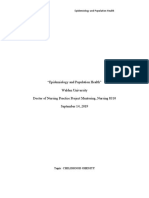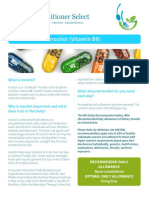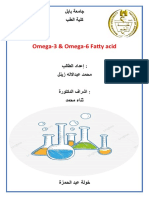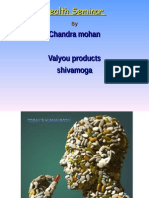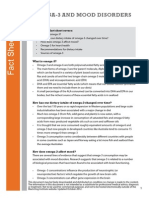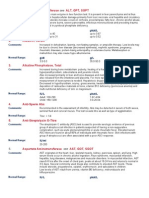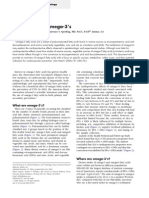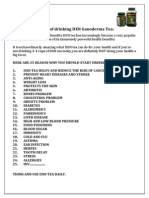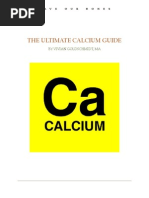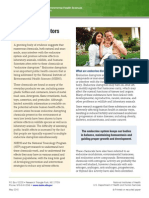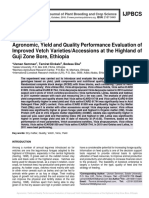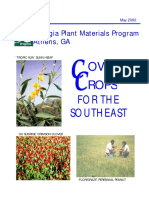Inositol PDF
Inositol PDF
Uploaded by
Tio Prima SCopyright:
Available Formats
Inositol PDF
Inositol PDF
Uploaded by
Tio Prima SOriginal Description:
Original Title
Copyright
Available Formats
Share this document
Did you find this document useful?
Is this content inappropriate?
Copyright:
Available Formats
Inositol PDF
Inositol PDF
Uploaded by
Tio Prima SCopyright:
Available Formats
Degradation of myo-Inositol Profoundly Alters the Competitive Ability of Rhizobium in the Rhizosphere
J. Fry, P.S. Poole, *M. Wood School of AMS, *Department of Soil Science, University of Reading, Whiteknights, Reading, RG6 6AJ.
Introduction myo-Inositol is the most abundant sugar/polyol in soil. With arabinose, myo-inositol is the principal sugar in root exudates of hydroponically grown legumes (Stanway and Wood, 1998). Rhizobium leguminosarum biovar viciae forms nodules on Pisum sativum and Vicia sativa, which has an inducible pathway for myo-inositol (Poole et al, 1994) (fig.1). Despite being abundant in legume root nodules, myo-inositol does not appear to be catabolised by Hypothesis We hypothesise that the ability to utilise myoinositol is important for growth and competition in the rhizosphere. myo-Inositol degradation pathway myo-inositol myo-inositol dehydrogenase 2-deoxy-5-keto-D-gluconic acid DKH kinase diketohydroxy phosphate DKHP aldolase 3.
myo-Inositol catabolic mutants of R. leguminosarum bv. viciae Transposon mutants deficient for growth on myo-inositol have been isolated. Three distinct regions containing genes involved in myo-inositol utilisation have been identified.
Competition studies between myo-inositol utilisation mutants and wildtype in vivo. The three mutants nodulate Pisum sativum (common pea) and Vicia sativa (common vetch) and fix nitrogen at the same rate as the wildtype (Poole et al, 1994). When co-inoculated in equal numbers onto peas and vetch in sterile conditions, over 90% of nodules recovered contained wildtype bacteria and not the mutants (fig.2). This advantage is still evident when seedlings are inoculated with 100-fold higher doses of the mutant strains than the wildtype (data not shown).
1.
Strain RU360 is mutated in an acetolactate synthase gene. Immediately downstream are two other genes thought to be involved in myo-inositol utilisation. Strain RU361 is mutated in a methylmalonic semialdehyde dehydrogenase. This is one of the final enzymes in the degradation pathway. Strain RU307 is mutated in a gene thought to be involved in transport of myo-inositol.
2.
Bacteria recovered from Vicia sativa nodules
total no. nodules recovered per replicate
100 90 80 70 60 50 40 30 20 10 0
RU361 RU360 3841
Expression of promoters induced by myo-inositol Screening of a library of Green Fluorescent Protein (GFP) gene fusions to Rhizobium promoters has enabled identification of promoters induced in the presence of myoinositol. These fusions will be tested to determine whether the promoters are induced in the plant rhizosphere.
2-keto-myo-inositol 2-keto-inositol dehydratase
uninoculated
3841
RU360 Treatment
RU361
3841 + RU360
3841 + RU361
D-2,3-diketo-4-deoxy-epi-inositol
Fig.2
Conclusions References Poole, P.S., Blyth, A., Reid, C.J., Walters, K. (1994). Microbiology. 140: 2787-2795. Stanway, A.P., Wood, M. (1998). Submitted. pyruvate Plant and Soil. There are at least three distinct gene clusters involved in myoinositol utilisation in R. leguminosarum bv. viciae. These regions appear to be under the control of a common regulator. Data obtained indicate that the ability to utilise myo-inositol confers a profound competitive advantage to Rhizobium for growth or nodulation in the rhizosphere. The effects on rhizosphere colonisation are currently being investigated.
malonic semialdehyde + dihydroxyacetone phosphate MSA oxidative decarboxylase acetyl CoA + CO2 + NADH
acetolactate synthase acetolactate Fig.1
You might also like
- Consumers About ImmunocalDocument163 pagesConsumers About ImmunocalLaura SurduNo ratings yet
- Nutrilite W.O.W: Bodykey Personalised Holistic Weight Management ProgramDocument19 pagesNutrilite W.O.W: Bodykey Personalised Holistic Weight Management Programrahul gajbhiye100% (2)
- Child Obesity AssignmentDocument6 pagesChild Obesity AssignmentElonna AnneNo ratings yet
- InositolDocument4 pagesInositolErick Fabricio Sarmiento Romo100% (1)
- Summary of Peer-Reviewed Science On ProtandimDocument1 pageSummary of Peer-Reviewed Science On ProtandimIe InterneXpertsNo ratings yet
- Dynamic AccumulatorsDocument4 pagesDynamic AccumulatorsAnonymous zNx6QUNtxmNo ratings yet
- Algalif Natural Astaxanthin Review of Human Clinical Studies 0917 WebDocument27 pagesAlgalif Natural Astaxanthin Review of Human Clinical Studies 0917 WebKorry Meliana PangaribuanNo ratings yet
- Sea Buckthorn - LaunchDocument26 pagesSea Buckthorn - LaunchShouvik DasNo ratings yet
- Scanner Trifold BrochureDocument2 pagesScanner Trifold BrochureCherry San DiegoNo ratings yet
- Rigvir EbookDocument32 pagesRigvir EbookatidevaNo ratings yet
- Doctors OpinionDocument30 pagesDoctors Opinionitsjai1303m80100% (1)
- Nutritional Content and Health Benefits of SeafoodDocument17 pagesNutritional Content and Health Benefits of SeafoodElavarasan KrishnamoorthyNo ratings yet
- CortitrolDocument11 pagesCortitrolCherry San DiegoNo ratings yet
- Usana: Health ProductsDocument30 pagesUsana: Health ProductsAdrian Gamboa MarcellanaNo ratings yet
- Venotropics SupplementsDocument10 pagesVenotropics SupplementsAyon KhanNo ratings yet
- Omega Fatty Acids and Their Role in Cardiovascular DiseasesDocument13 pagesOmega Fatty Acids and Their Role in Cardiovascular DiseasesSana IqbalNo ratings yet
- Pure Antarctic Krill Oil For Maximum Omega 3Document3 pagesPure Antarctic Krill Oil For Maximum Omega 3osumex100% (1)
- Natural Astaxanthin: The Whole Body Benefits ofDocument20 pagesNatural Astaxanthin: The Whole Body Benefits ofAshiraChayilNo ratings yet
- Breast Secretion or DischargeDocument3 pagesBreast Secretion or DischargeVinay DwivediNo ratings yet
- Why Onion and Zobo Can Treat Infertility in MenDocument2 pagesWhy Onion and Zobo Can Treat Infertility in MenkarlseacrestNo ratings yet
- Omega-3 Fatty Acids For CardioprotectionDocument10 pagesOmega-3 Fatty Acids For Cardioprotectionbalderchow100% (1)
- Targeted Therapy in CancerDocument51 pagesTargeted Therapy in CancerSatya WangsaNo ratings yet
- DR Sears Book-AstaxantinaDocument74 pagesDR Sears Book-Astaxantinacenagy100% (1)
- Black Seed InformationDocument4 pagesBlack Seed InformationSuresh UmadiNo ratings yet
- Effect of Epitalon and Melatonin On Life Span and Spontaneous Carcinogenesis in Senescence Accelerated Mice (SAM)Document2 pagesEffect of Epitalon and Melatonin On Life Span and Spontaneous Carcinogenesis in Senescence Accelerated Mice (SAM)mikalraNo ratings yet
- Omega 3 Buyers GuideDocument19 pagesOmega 3 Buyers GuidecapercrewNo ratings yet
- Omega-3 & Omega-6 Fatty AcidDocument6 pagesOmega-3 & Omega-6 Fatty Acidمحمود الموسويNo ratings yet
- Snap-8 0907sDocument24 pagesSnap-8 0907sapi-291771056No ratings yet
- What Is Lifestream Astazan?: Helps Recovery Time After ExerciseDocument1 pageWhat Is Lifestream Astazan?: Helps Recovery Time After ExerciseGary MollerNo ratings yet
- Capsules Brochure UK FNLDocument4 pagesCapsules Brochure UK FNLSolai RajanNo ratings yet
- Health Seminar PresentationDocument46 pagesHealth Seminar Presentationmr_harshahsNo ratings yet
- Injectable GlutathioneDocument8 pagesInjectable Glutathionemilad bigdeliNo ratings yet
- DCA Dosage and Usage. DCA For Cancer Treatment (Long Guide)Document9 pagesDCA Dosage and Usage. DCA For Cancer Treatment (Long Guide)DcaGuideNo ratings yet
- ReversAge BrochureDocument2 pagesReversAge BrochureReliv InternationalNo ratings yet
- Omega 3andmooddisordersDocument4 pagesOmega 3andmooddisorderscatsdeadnowNo ratings yet
- Use of CoQ10 To Treat MalignanciesDocument2 pagesUse of CoQ10 To Treat MalignanciesTUartistNo ratings yet
- Alanine Aminotransferase Alt, GPT, SGPT: Iu/L Kat/lDocument8 pagesAlanine Aminotransferase Alt, GPT, SGPT: Iu/L Kat/lLuis Ferdinand Dacera-Gabronino Gamponia-NonanNo ratings yet
- (Cáncer - Comparativa) - 6. Ellagic AcidDocument7 pages(Cáncer - Comparativa) - 6. Ellagic Acidpedpix100% (1)
- Understanding Omega3Document7 pagesUnderstanding Omega3kikevasquezNo ratings yet
- Coleus Forskohlii and Its Forskolin A ReviewDocument5 pagesColeus Forskohlii and Its Forskolin A ReviewESSENCE - International Journal for Environmental Rehabilitation and ConservaionNo ratings yet
- NutraEU Whitepaper AprilDocument7 pagesNutraEU Whitepaper AprilAlgae-TechNo ratings yet
- aCDN Calcium Mineral CompDocument1 pageaCDN Calcium Mineral Compapi-3714923No ratings yet
- Herbs in Dentistry: ReviewarticleDocument10 pagesHerbs in Dentistry: ReviewarticleYousuf AdamNo ratings yet
- Natural Tea Give Health Benefits (A3 Size)Document8 pagesNatural Tea Give Health Benefits (A3 Size)itsjai1303m80100% (1)
- Optimal Mar2012-V 2Document4 pagesOptimal Mar2012-V 2api-97602678No ratings yet
- Impact of Testosterone On Hair and Skin 2161 1017 1000187Document4 pagesImpact of Testosterone On Hair and Skin 2161 1017 1000187jooo93No ratings yet
- Cancer Treatment - TurkeyDocument16 pagesCancer Treatment - TurkeySaadet DagistanliNo ratings yet
- The Ultimate Calcium Guide: by Vivian Goldschmidt, MaDocument10 pagesThe Ultimate Calcium Guide: by Vivian Goldschmidt, MaAdy CatalinNo ratings yet
- 5-Alpha-Reductase Inhibitor PDFDocument8 pages5-Alpha-Reductase Inhibitor PDFP. GuadamuzNo ratings yet
- Pao-Pereira 20 Benefits PDFDocument2 pagesPao-Pereira 20 Benefits PDFHerbNo ratings yet
- Am J Cardiol Deha EpaDocument10 pagesAm J Cardiol Deha EpajoremeNo ratings yet
- Nutrilite Concentrated Fruit and VegetablesDocument18 pagesNutrilite Concentrated Fruit and VegetablesAchyut SadotraNo ratings yet
- Beta Glucan Book PDFDocument51 pagesBeta Glucan Book PDFnvestgrrlNo ratings yet
- Optimal May 2012Document5 pagesOptimal May 2012api-97602678No ratings yet
- Vitamin DeficiencyDocument5 pagesVitamin Deficiencyritika jainNo ratings yet
- P 4 Maple Syrup Urine DiseaseDocument9 pagesP 4 Maple Syrup Urine Diseaseapi-308145910No ratings yet
- PCOS and Infertility - Causes and TreatmentDocument42 pagesPCOS and Infertility - Causes and TreatmentlouloucheNo ratings yet
- Iron Deficiency in Pregnancy and The Rationality of Iron Supplements Prescribed During PregnancyDocument18 pagesIron Deficiency in Pregnancy and The Rationality of Iron Supplements Prescribed During PregnancySOFIA SETIANo ratings yet
- Endocrine Disruptors 508Document4 pagesEndocrine Disruptors 508isaco1531012No ratings yet
- Melatonin: A Beginner's 3-Week Guide on How to Leverage Melatonin for Anti-Aging, Sleep Quality, and Brain HealthFrom EverandMelatonin: A Beginner's 3-Week Guide on How to Leverage Melatonin for Anti-Aging, Sleep Quality, and Brain HealthNo ratings yet
- Low Platelets, A Simple Guide To The Condition, Diagnosis, Treatment And Related ConditionsFrom EverandLow Platelets, A Simple Guide To The Condition, Diagnosis, Treatment And Related ConditionsRating: 5 out of 5 stars5/5 (1)
- Departemen Ilmu Gizi FK USU MedanDocument25 pagesDepartemen Ilmu Gizi FK USU MedanTio Prima SNo ratings yet
- Pekanbaru - Medan (7 Orang Rsu. Puri Husada)Document3 pagesPekanbaru - Medan (7 Orang Rsu. Puri Husada)Tio Prima SNo ratings yet
- Varicella-Zoster Virus: Virology and Clinical ManagementDocument19 pagesVaricella-Zoster Virus: Virology and Clinical ManagementTio Prima SNo ratings yet
- Review Typhoid Fever As Cellular Microbiological Model: Rev. Inst. Med. Trop. S. Paulo 45 (4) :185-191, July-August, 2003Document7 pagesReview Typhoid Fever As Cellular Microbiological Model: Rev. Inst. Med. Trop. S. Paulo 45 (4) :185-191, July-August, 2003Tio Prima SNo ratings yet
- Current Progress in Dengue Vaccines: Review Open AccessDocument9 pagesCurrent Progress in Dengue Vaccines: Review Open AccessTio Prima SNo ratings yet
- Guest Essay Envisioning A Sustainable Society: Is A Trademark Used Herein Under LicenseDocument4 pagesGuest Essay Envisioning A Sustainable Society: Is A Trademark Used Herein Under LicenseTio Prima SNo ratings yet
- EScholarship UC Item 3p2984p2Document3 pagesEScholarship UC Item 3p2984p2Tio Prima SNo ratings yet
- Management of Adult Febrile Neutropenia: 15011500-10123 99 Street Edmonton, Alberta T5J 3H1Document4 pagesManagement of Adult Febrile Neutropenia: 15011500-10123 99 Street Edmonton, Alberta T5J 3H1Tio Prima SNo ratings yet
- Fever of Unknown OriginDocument6 pagesFever of Unknown OriginTio Prima SNo ratings yet
- Leptospirosis (Weil's Disease) : EpidemiologyDocument4 pagesLeptospirosis (Weil's Disease) : EpidemiologyTio Prima SNo ratings yet
- Global Epidemiological Overview of LeptospirosisDocument7 pagesGlobal Epidemiological Overview of LeptospirosisTio Prima SNo ratings yet
- References 2Document2 pagesReferences 2Tio Prima SNo ratings yet
- Idiopathic Ketotic Hypoglycemia Presenting As Febrile SeizuresDocument2 pagesIdiopathic Ketotic Hypoglycemia Presenting As Febrile SeizuresTio Prima SNo ratings yet
- Plant Variety Catalogues Agricultural Plant SpeciesDocument887 pagesPlant Variety Catalogues Agricultural Plant SpeciesDenis MartinićNo ratings yet
- Grain Legumes 57 LentilsDocument60 pagesGrain Legumes 57 LentilsDavide AbdelalNo ratings yet
- In Vitro Plant Regeneration From Narbon Vetch (Vicia Narbonensis L.) Using Cotyledonary Node ExplantsDocument4 pagesIn Vitro Plant Regeneration From Narbon Vetch (Vicia Narbonensis L.) Using Cotyledonary Node ExplantsAriana ChimiNo ratings yet
- Ijcepa x01 eDocument574 pagesIjcepa x01 esandeepktekleNo ratings yet
- Introduction To The Talking Neolithic WoDocument33 pagesIntroduction To The Talking Neolithic WoJoshua DesdichadoNo ratings yet
- Green Manure 4Document37 pagesGreen Manure 4Romeo ŠainNo ratings yet
- N Fixing Plants For Temperate ClimateDocument3 pagesN Fixing Plants For Temperate ClimateSebastian GhermanNo ratings yet
- Thelentil Botanyproductionanduses 140718234710 Phpapp01 PDFDocument478 pagesThelentil Botanyproductionanduses 140718234710 Phpapp01 PDFariadnamilianiNo ratings yet
- 3rd EditionDocument29 pages3rd EditionFikiru WakoyaNo ratings yet
- Fearc 03 1347394Document18 pagesFearc 03 1347394oolestiNo ratings yet
- Plant Variety Catalogues - Agricultural Plant SpeciesDocument779 pagesPlant Variety Catalogues - Agricultural Plant SpeciesKenNo ratings yet
- Organic Growers Supply 2013 Catalog HighresDocument39 pagesOrganic Growers Supply 2013 Catalog HighresendlesssmithNo ratings yet
- A List of Forage Grasses and Scoentific NameDocument5 pagesA List of Forage Grasses and Scoentific NameXz Rivera75% (4)
- Agronomic, Yield and Quality Performance Evaluation of Improved Vetch Varieties/Accessions at The Highland of Guji Zone Bore, EthiopiaDocument6 pagesAgronomic, Yield and Quality Performance Evaluation of Improved Vetch Varieties/Accessions at The Highland of Guji Zone Bore, EthiopiaPremier PublishersNo ratings yet
- National Plant Protection Organization (Nppo) : A Presentation byDocument16 pagesNational Plant Protection Organization (Nppo) : A Presentation byShailendra TripathiNo ratings yet
- AJPS-05.01.24-2343 For Peer Review OnlyDocument17 pagesAJPS-05.01.24-2343 For Peer Review Onlymuhammadjuniad1983No ratings yet
- USDA - Cover Crops For The SoutheastDocument39 pagesUSDA - Cover Crops For The SoutheastPhi MaichiNo ratings yet
- Inositol PDFDocument1 pageInositol PDFTio Prima SNo ratings yet
- The Effects of PGPR On Germination of Some Legume Forage Crops SeedsDocument10 pagesThe Effects of PGPR On Germination of Some Legume Forage Crops SeedsHazım Serkan TenikecierNo ratings yet
- SGSV by Taxon 20180120Document494 pagesSGSV by Taxon 20180120Anonymous u6UofmNo ratings yet
- A B Biernacki E Klenina G Pashkevych SomDocument16 pagesA B Biernacki E Klenina G Pashkevych SomAna HoncuNo ratings yet
- Duranti 2006 - Grain Legume Proteins and Nutraceutical Properties PDFDocument16 pagesDuranti 2006 - Grain Legume Proteins and Nutraceutical Properties PDFValeriu MunteanuNo ratings yet
- Book of Abstracts PDFDocument203 pagesBook of Abstracts PDFionescu_ion_3No ratings yet
- Feedstuff IdentificationDocument2 pagesFeedstuff IdentificationMeljun LazoNo ratings yet
- Cover Crop Grow Guide Links - Analytics - 2Document64 pagesCover Crop Grow Guide Links - Analytics - 2Ooogittttty BoooggiiitttyyNo ratings yet
- Sorghum (Sorghum Bicolor (L.)Document6 pagesSorghum (Sorghum Bicolor (L.)Andrae GenusNo ratings yet
- Cover Crop Solutions Web 2013Document2 pagesCover Crop Solutions Web 2013Leonardo ShibataNo ratings yet
- Simple Field Planting Records TemplateDocument7 pagesSimple Field Planting Records TemplateDevang shrivasNo ratings yet
- Effects of Crop Mixtures On Leaf Rust Development On Faba Bean Grown in PalestineDocument9 pagesEffects of Crop Mixtures On Leaf Rust Development On Faba Bean Grown in PalestineHassan AbuqaoudNo ratings yet


